Introduction
Twenty years ago, when B2B marketers were just beginning to leverage behavioral targeting in their digital ad spends, few could’ve ever imagined how influential targeting data would eventually become. These days, nearly all digital campaigns use data to target their specific audiences.
Not too long ago, ad buyers might’ve said, “I need to reach senior executives working at organizations with more than 5,000 employees, or generating more than a billion in annual revenue.” And then they would’ve found that The Wall Street Journal had one of the highest concentrations of their audience (even though many readers were not part of their audience).
Today, audience data lets them target only the audience they care about, eliminating potentially wasted investments.
Objective-based advertising, in which advertisers build ad campaigns around specific business goals, makes this easier than ever. By setting objectives, systems are able to both improve reporting — they report against your specific objective — and implement some level of automatic optimization to improve results.
Where the B2B action is: Social networks
A savvy combination of behavioral and objective-based advertising empowers revenue teams to be highly targeted and effective with their advertising.
Social networks excel at supporting these business goals, and of the bunch, B2B leaders prefer investing in LinkedIn ads over those on Facebook, YouTube, and Twitter.
- Nearly 85% of buying teams use LinkedIn as part of their purchase process
- 4 out of 5 LinkedIn members drive business decisions
- LinkedIn’s audience also has 2x the buying power of the average web audience
One factor above all often informs why revenue teams invest in LinkedIn: the depth, richness, and quality of LinkedIn’s user data, which enables ad buyers to target B2B audiences with more
LinkedIn’s data quality = Superior targeting
This is because LinkedIn’s data is different. LinkedIn members are incentivized to provide accurate information about themselves to help grow their professional networks, improve their professional development, look for jobs, and more.
With visibility into granular contact information like skills, job history, education, and interests, advertisers can engage accounts with unparalleled precision.
With LinkedIn, revenue teams can create ads that exclusively target professionals who use Marketo. Or Salesforce. Or who attended Wharton from 1980 to 1988. No other social platform provides this kind of precise targeting for B2B sellers.
What is 6sense?
6sense is the only revenue technology platform that captures intent signals from every known and anonymous source, and connects it all to prospect accounts. It delivers complete insight into the buying journey.
6sense’s patented AI platform scores over a quarter-billion accounts and people every day in order to reconstruct the account-based buyer journey for your business, monitoring and analyzing changes in buyer intent at a massive scale.
The importance of in-market data to prioritize ad dpend
Marketers have been buying digital ads for decades, yet still struggle to properly prioritize audiences and budgets. That’s because the audience is bigger than ever, the ads are expensive, and we never have enough money to reach all the constituents we want to reach. We have to prioritize our investments.
A powerful — and differentiating — combination of 6sense + LinkedIn is a revenue team’s ability to target companies that are in-market for a solution now. This allows for prioritizing certain accounts while continuing to use all the other targeting data LinkedIn offers.
This ability to target based on timing isn’t otherwise available in LinkedIn.
When buying teams are tasked with finding products or solutions for their organizations, they spend time conducting research online anonymously on third-party sites, such as industry publications, blogs, social networks, and product review sites like G2 and TrustRadius.
On their own, advertisers can’t detect this invaluable-yet-invisible data. But 6sense’s platform can illuminate and analyze it. Through AI and machine learning, the platform automatically determines who is in-market now and most likely to buy from you, giving you new tools for prioritizing ad spending and improving ad performance.
Dynamic 6sense segments are available for any LinkedIn campaign and provide new insights, including:
- Unparalleled visibility into where buyers are in their respective journeys (we call these
- “in-market” stages)
- The topics buyers are most interested in (or concerned about) based on their journey stage
- Timing on when buyers may — or may not — be interested in personalized engagement
These data points, plus many others, are accessible in real time through 6sense and actionable through our LinkedIn integration. Revenue teams have greater control over the types of accounts and buyers to target.
This control minimizes ad spend and maximizes ad impact. With the power of predictive analytics, 6sense customers:
- Perform nearly 2x better than the standard LinkedIn clickthrough rate benchmark
- And at costs 13% lower for cost per click than LinkedIn’s CPC benchmark
6 campaign ‘recipes’ that deliver game-changing engagement
When you combine the robust audience data from LinkedIn with the intent signals from 6sense, you can engage the right customers for your solution with the right message, right when they’re ready to buy. Here are step-by-step instructions for creating campaigns that address five unique use cases.
Recipe #1: LinkedIn lead gen campaigns
Lower your cost-per-lead by targeting in-market accounts that are currently researching specific and relevant keywords associated with your business. (At 6sense, we use the term “in-market” to represent moments in a buyer’s journey where their interest in buying intersects with their interest in your solution.)
In this example, we’re using keywords associated with ABM that would be related to your business and/or competitors.
6sense segment filter
Keywords Researched (used to ensure relevancy and timeliness of ad content)
In-Market Stage: Decision and Purchase
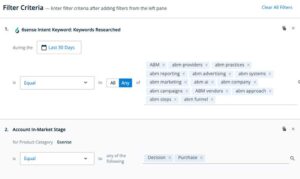
Linkedin campaign objective
Lead Generation
Website Conversion (preferred for future retargeting capability and higher quality conversions)
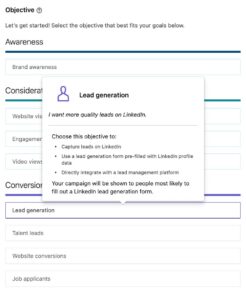
LinkedIn audience targeting
Your typical buyer persona
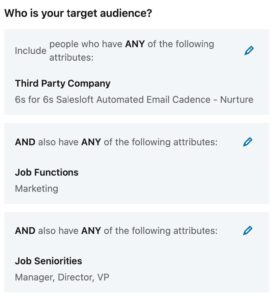
LinkedIn ad type
Single image ad
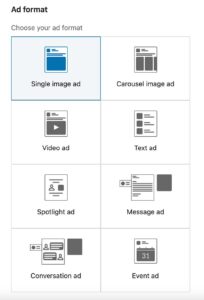
Content to use:
- Middle- to bottom-of-funnel assets:
- Ebooks
- Buying guides
- Case studies or customer stories
Recipe #2: Highly targeted remarketing campaigns
Combine 6sense in-market data with accounts that have already visited your website to create higher-performing remarketing campaigns.
6sense segment filter
URLs Visited
In-Market Stages: Consideration, Decision, and Purchase
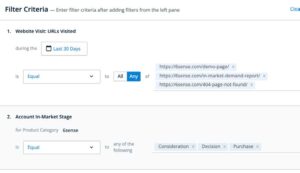
LinkedIn campaign objective
Lead Generation
Website Conversion
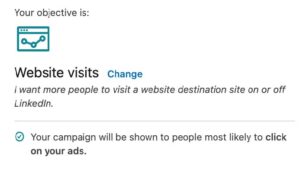
LinkedIn target audience
Your 6sense segment
Your typical buyer persona

LinkedIn ad type
Single image

Content to use:
- High-value and middle- to bottom-of-funnel assets:
- Analyst reports
- Demo/“Contact Us” offers on pages visited, but forms not completed
- Case studies
Recipe #3: Pipeline acceleration campaigns
Target these accounts with open opportunities to accelerate the deal cycle.
6sense segment filter
Salesforce Opportunity
Opportunity Value

LinkedIn campaign objective
Website visit
Video views

Linkedin audience targeting
Your 6sense segment
Expanded targeting from your typical buyer persona to also include C-level executives and finance leaders
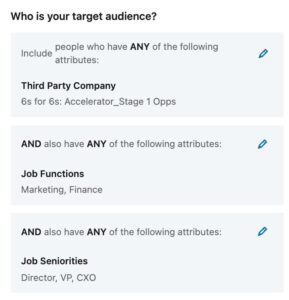
LinkedIn ad type
Single image ad
Video ad

Content to use:
- Custom landing page featuring a mix of case studies, customer testimonials, and analyst reports
- Landing page highlighting current G2 review
Recipe #4: Event registration
This targets customers and prospects to drive registrations for an in-person or virtual event. The content for these campaigns can connect interest, industry, or buying stage to key event takeaways.
6sense segment filters
In-Market Stage: Awareness, Consideration, Decision, Purchase
Keywords Researched: Event title, 30-day timeline
URLs Visited: Event website, 30-day timeline
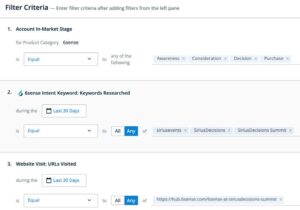
LinkedIn campaign objective
Website Conversions
Website Visit
Event Registration
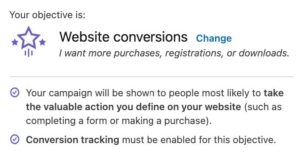
LinkedIn target audience
Your 6sense segment
Your typical buyer persona up to C-level executives

LinkedIn ad type
Your 6sense segment
Your typical buyer persona up to C-level executives
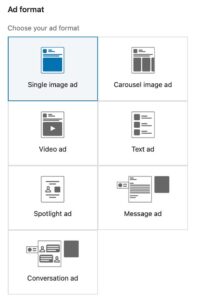
Recipe #5: Outbound
This targets top prospect accounts to drive inbound and/or provide brand air cover for the outbound sales motion.
6sense segment filters
Accounts in Segment: Your high intent segment (Consideration, Decision, Purchase)
Keywords Researched: All Competitors, Your Company, 30-day time frame
Salesforce Opportunity Value (to remove activity opportunities)
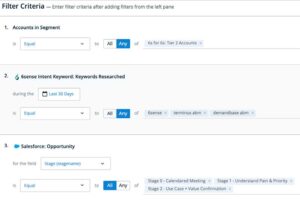
LinkedIn campaign objective
Website Visit
Website Conversions

LinkedIn audience targeting
Your 6sense segment
Your typical buyer persona and above
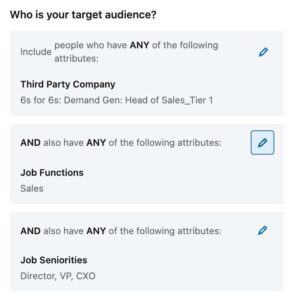
LinkedIn ad type
Single image ad

Content to use:
- Thought leadership
- Third-party reports
- Product information
Recipe #6: Customer Retention
Proactively target existing customers that have researched competitors in the last 30 days to get your CSM team ahead of the competition.
6sense segment filters
Accounts in Segment: Your customer segment
Keywords Researched: All Competitors, 30-day time frame

LinkedIn campaign objective
Website Visit
Video Views
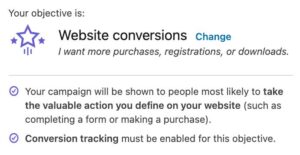
LinkedIn audience targeting
Your 6sense segment
The end-users of your product

Linkedin ad type
Single image ad
Video ad
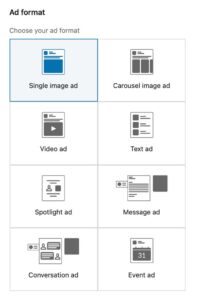
Content to use:
- Analyst reports
- Landing page offering utilization or account “health checks” of your products
- Industry/partner technology-specific case studies
Conclusion
Just like today’s B2B marketers can’t imagine lacking the audience data we have at our fingertips, the time is soon approaching when we won’t be able to fathom B2B marketing without intent data.
Leveraging a revenue technology platform like 6sense (which is capable of accurately capturing buyer intent signals) combined with the rich user data LinkedIn provides will have you ahead of the curve when that time comes.
LinkedIn and 6sense work seamlessly together to help B2B marketers reach the audiences they care about with the content they want to see — at the time they’re most welcome to hear it.
The result? You minimize your digital ad spend while maximizing the impact of your ad campaigns.




